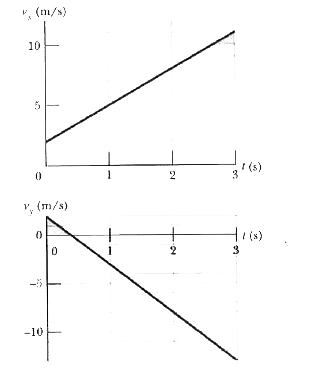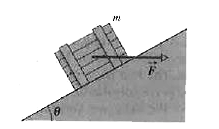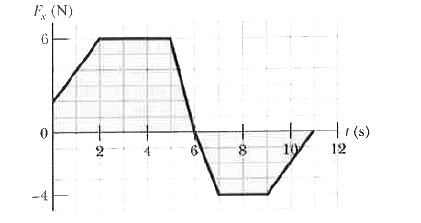PROBLEMS from RESNICK AND HALLIDAY PHYSICS (HINGLISH) FORCE AND MOTION - I for Class 12
| Class 12 | PHYSICS |
| Chapter | FORCE AND MOTION - I |
| RESNICK AND HALLIDAY PHYSICS (HINGLISH) | PROBLEMS |
| Medium | English |
| Academic Year | 2023-2024 |
Question 2
Two horizontal forces act on a 2.5 kg chopping block that can slide over a frictionless kitchen counter, which lies in an xy plane. One force is →F1=(3.0 N)ˆi+(4.0N)ˆj. Find the acceleration of the chopping block in unit-vector notation when the other force is (a) →F2=(−3.0N)ˆi+(−4.0N)ˆj, (b) →F2=(−3.0N)ˆi+(4.0N)ˆj, and (c) →F2=(3.0N)ˆi+(−4.0N)ˆj. View SolutionQuestion 5
Three astronauts, propelled by jet backpacks, push and guide a 120 kg asteroid toward a processing dock, exerting the forces shown in Fig. 5-37, with F1=32N,F2=55N,F3=41N,θ1=30∘, and θ3=60∘. What is the asteroid's acceleration (a) in unit-vector notation and as (b) a magnitude and (c) a direction relation relative to the positive direction of the x axis ?
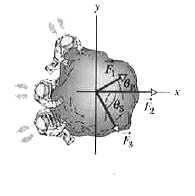 View Solution
View SolutionQuestion 6
There are two forces on the 2.00 kg box in the overhead view of Fig. 5-38, but only one is shown. For F1=20.0N,a=12.0 m/s2, and θ=30.0∘, find the second force (a) in unit-vector notation and as (b) a magnitude and ( c ) an angle relative to the positive direction of the x axis.
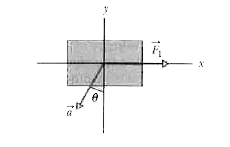 View Solution
View SolutionQuestion 8
In an xy plane, a 0.450 kg object moves is such a way that x(t)=−16.0+3.00t−5.00t3 and y(t)=26.0+8.00t−10.0t2, where x and y are measured in meters and t in seconds. At t = 0.800 s, find (a) the magnitude and (b) the angle, relative to the positive direction of the x axis, of the net force on the object, and ( c ) the angle of the object's travel direction. View SolutionQuestion 10
A 3.0 kg object is driven along an x axis by a variable force that is directed along that axis. Its position is given by x=4.0 m+(5.0 m/s)t+kt2−(3.0 m/s3)t3, where x is measured in meters and t in seconds. The factor k is a constant. At t = 4.0 s, the force on the particle has a magnitude of 37 N and is in the negative direction of the axis. Find the value of k. View SolutionQuestion 11
Two horizontal forces →F1 and →F2 act on a 4.0 kg disk that slides over frictionless ice, on which an xy coordinate system over frictionless ice, on which an xy coordinate system is laid out. Force →F1 is in the positive direction of the x axis and has a magnitude of 7.0 N. Force →F2 has a magnitude of 9.0 N. Figure 5-39 gives the x component vx of the velocity of the disk as a function of time t during the sliding. What is the angle between the constant directions of forces →F1 and →F2 ?
 View Solution
View SolutionQuestion 12
Two particles of masses m and 2m are placed on a smooth horizonttal table. A string, which joins these two masses, hangs over the edge supporting a pulley, which suspends a particle of mass 3m, as shown in Fig. 5-40. The pulley has negligible mass. The two parts of the string on the table are parallel and perpendicular to the edge of the table. The hanging parts of the string are vertical. Find the acceleration of the particle of mass 3m.
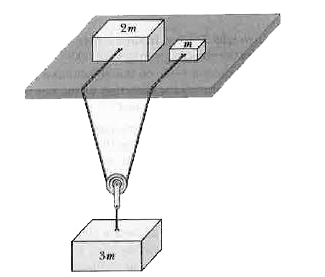 View Solution
View SolutionQuestion 14
(a) An 11.0 kg salami is supported by a cord that runs to a spring scale, which is supported by a cord hung from the ceiling (Fig. 5-41a). What is the reading on the scale, which is marked in SI weight units? (This is a way to measure weight by a cord that runs around a pulley and to a scale.The opposite end of the scale? (This is the way by a physics major.) ( c ) In Fig. 5-41c the wall has been replaced with a second 11.0 kg salami, and the assembly is stationary. What is the reading on the scale? (This is the way by a deli owner who was once a physics major.)
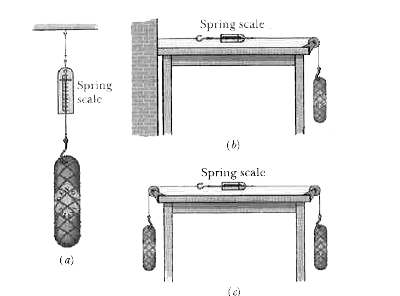 View Solution
View SolutionQuestion 16
A car traveling at 63 km/h hits a bridge abutment. A passenger in the car moves forward a distance of 65 cm (with respect to the road) while being brought to rest by an inflated air bag. What magnitude of force (assumed constant) acts on the passenger's upper torso, which has a mass of 41 kg ?View SolutionQuestion 18
Tarzan, who weighs 860 N, swings from a cliff att the end of a 20.0 m vine that hangs from a high tree limb and initially makes an angle of 22.0∘ with the vertical. Assume that an x axis extends horizontally away from the cliff edge and a y axis extends upward. Immediately after Tarzan steps of the cliff, the tension in the vine is 760 N. Just then, what are (a) the force on him from the vine in unit-vector notation and as (c) a magnitude and (d)an angle relative to the positive direction of Tarzon's acceleration just then ? View SolutionQuestion 19
There are two horizontal forces on the 2.0 kg box in the overhead view of Fig. 5-43 but only one (of magnitude F1=30 N) is shown. The box moves along the x axis. For each of the following values of the acceleration ax of the box, find the second force in unitvector notation: (a) 10 m/s2, (b) 20 m/s2, (c) 0, (d) −10 m/s2, and (e) −20 m/s2.
 View Solution
View SolutionQuestion 21
A car that weighs 1.30×104 N is initially moving at 35 km/h when the brakes are applied and the car is brought to a stop in 15 m. Assuming the force that stops the car is constant, find (a) the magnitude of the force and (b) the time required for the car experiences the same force during the braking, by what factors are (c) the stopping distance and (d) the stopping time multiplied? (There could be a lesson here about the danger of driving at high speeds.)View SolutionQuestion 22
A firefighter who weighs 689 N slides down a vertical pole with an acceleration of 2.00 m/s2, directed downward. What are the (a) magnitude and (b) direction (up or down) of the vertical force on the firefighter from the pole and the ( c ) magnitude and (d) direction of the vertical force on the pole from the firefighter ? View SolutionQuestion 23
Figure 5-44 shows an overhead view of a 0.0250 kg lemon half and two of the three horizontal forces that act on it as it is on a fric tionless table. Force →F1 has a magnitude of 6.00 N and is at θ1=30.0∘. Force →F2 has a magnitude of 7.00 N and is at
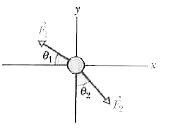
θ2=30.0∘. In unit-vector notation, what is the third force if the lemon half (a) is stationary, (b) has the constant velocity →v=(13.0ˆi−14.0ˆj) m/s, and ( c ) has the varying velocity ¯v=(13.0tˆi−14.0tˆj) m/s2, where t is time? View SolutionQuestion 24
A 1500 kg cable car moves vertically by means of a cable that connects the ground and the top of a hill. What is the tension in the supporting cable when the cab, originally moving downard at a speed of 9.0 m/s, is brought to rest with constant acceleration in a distance of 38 m. View SolutionQuestion 27
Holding on to a tow rope moving parallel to a frictionless ski slope, a 45 kg skier is pulled up the slope, which is at an angle of 8.0∘ with the horizontal. What is the magnitude Frope of the force on the skier from the rope when (a) the magnitude v of the skier's velocity is constant at 2.0 m/s and (b) v = 2.0 m/s as v increases at a rate of 0.10 m/s2 ?View SolutionQuestion 28
A boy with a mass of 35 kg and a sled with a mass of 6.5 kg are on the frictionless ice of a frozen lake, 12 m apart but connected by a rope of negligible mass. The boy exerts a horizontal 4.2 N force on the rope. What are the acceleration magnitudes of (a) the sled and (b) the boy ? ( c ) How far from the boy's initial position do they meet ? View SolutionQuestion 29
A 50 kg skier skis directly down a frictionless slope angled at 10∘ to the horizontal. Assume the skier moves in the negative direction of an x axis along the slope. A wind force with component Fx acts on the skier. What is Fx if the magnitude of the skier's velocity is (a) constant, (b) increasing at a rate of 1.0 m/s2, and (c) increasing at a rate of 2.0 m/s2 ? View SolutionQuestion 31
A dated box of dates, of mass 4.50 kg, is sent sliding up a frictionless ramp at an angle of θ to the horizontal. Figure 5-46 gives, as a function of time t, the component vx of the box's velocity along an x axis that extends directly up the ramp. What is the magnitude of the normal force on the box from the ramp ?
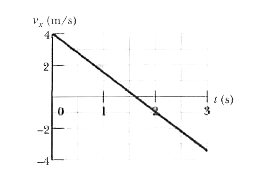 View Solution
View SolutionQuestion 32
In earlier days, horses pulled barges down canals in the manner shown in Fig. 5-47. Suppose the horse pulls on the rope with a force of 8600 N at an angle of θ=18∘ to the direction of motion of the barge, which is headed straight along the positive direction of an x axis. The mass of the barge is 9500 kg, and the magnitude of its acceleration is 0.12 m/s2. What are the (a) magnitude and (b) direction (relative to positive x) of the force on the barge from the water ?
 View Solution
View SolutionQuestion 33
If Fig. 5-48, a chain consisting of five links, each of mass 0.100 kg, is lifted vertically with constant acceleration of magnitude a=2.50 m/s2. Find the magnitudes of (a) the force on link 1 from link 2, (b) the force on link 2 from link 3, (c) the force on link 3 from link 4, and (d) the force on link 4 from link 5. Then find the magnitudes of (e) the force →F on the top link from the person lifting the chain and (f) the net force accelerating each link.
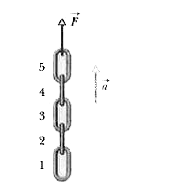 View Solution
View SolutionQuestion 37
The Zacchini family was renowned for their human-cannonball act in which a family member was shot from a cannon using either elastic bands or compressed air. In one version of the act, Emanuel Zacchhini was shot over three Ferris wheels to land in a net at the same height as the open end of the cannon and at a range of 69 m. He was propelled inside the barrel for 5.2 m and launched at an angle of 53∘. If his mass was 85 kg and he underwent consttant acceleration inside the barrel, what was the magnitude of the force propelling him? (Hint: Treat the launch as though it were along a ramp at 53∘. Neglect air drag.) View SolutionQuestion 38
Figure 5-50 shows two blocks connected by a cord (of negligible mass) that passes over a frictionless pulley (also of negligible mass). The arrangement is known as Atwood's machine. One block has mass m1=1.30 kg, the other has mass m2=2.80 kg. What are (a) the magnitude of the blocks' acceleration and (b) the tension in the cord ?
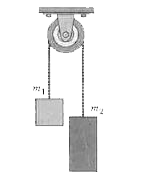 View Solution
View SolutionQuestion 40
As shown in Fig. 5-51, body C (2.9 kg) and body D (1.9 kg) are suspended from a rigid support by inextensible wires B and A, each of length 1.0 m. Wire B has negligible mass, wire A has a uniform density of 0.20 kg/m. The whole system undergoes an upward acceleration of magnitude 0.50 m/s2. Find the tension at the midpoint in (a) wire A and (b) wire B.
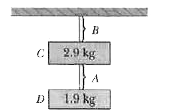 View Solution
View SolutionQuestion 41
Figure 5-52 shows four penguins that are being play-fully pulled along very slippery (frictionless) ice by a curator. The masses of three penguins and the tension in two of the cords are m1=12 kg,m3=15 kg,m4=20 kg, T2=111 N, and T4=222 N. Find the penguin mass m2 that is not given.
 View Solution
View SolutionQuestion 42
Two blocks are in contact on a frictionless table. A horizontal force is applied to the larger block, as shown in Fig. 5-53. (a) If m1=2.3 kg,m2=1.2 kg, and F = 3.2 N, find the magnitude of the force between the two blocks. (b) Show that if a force of the same magnitude F is applied to the smaller block but in the opposite direction, the magnitude of the force between the blocks is 2.1 N, which is not the same value calculated in (a). (c) Explain the difference.
 View Solution
View SolutionQuestion 43
In Fig. 5-54a, a constant horizontal force →Fa is applied to block A, which pushes against block B with a 15.0 N force directed horizontally to the right. In Fig. 5-54b, the same force →Fa is applied to block B, now block A pushes on block B with a 10.0 N force directed horizontally to the left. The blocks have a combined mass of 12.0 kg. What are the magnitudes of (a) their acceleration in Fig. 5-54a and (b) force →Fa ?
 View Solution
View SolutionQuestion 44
Figure 5-55 shows a man sitting in a bosun's chair that dangles from a mass-less rope, which runs over a massless, frictionless pulley and back down to the man's hand. The combined mass of man and chair is 103.0 kg. With what force magnitude must the man pull on the rope if he is to rise (a) with a constant velocity and (b) with an upward acceleration of 1.30 m/s2 ?
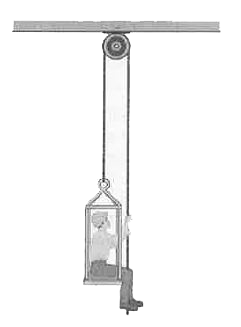 View Solution
View SolutionQuestion 45
A 10 kg monkey climbs up a massless rope that runs over a frictionless tree limb and back down to a 15 kg package on the ground (Fig. 5-56). (a) What is the magnitude of the least acceleration the monkey must have if it is to lift the package off the ground? If, after the package has been lifted, the monkey stops its climb and holds on to the rope, what are the (b) magnitude and (c) direction of the monkey's acceleratiohn and (d) the tension in the rope ?
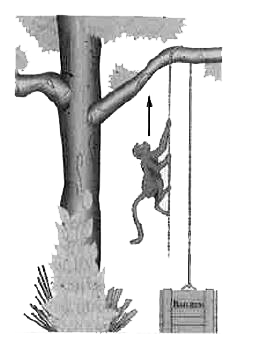 View Solution
View SolutionQuestion 46
Figure shows a 5.00 kg block being pulled along a frictionless floor by a cord that applies a force of constant magnitude 15.0 N but with an angle θ(t)that varies with time. When angle θ=25.0∘, at what rate is the acceleration of the block changing if (a) θ(t)=(2.00×10−2deg/s)t and (b) θ(t)=−(2.00×10−2deg/s)t ?
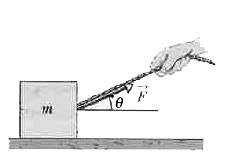 View Solution
View SolutionQuestion 47
A hot-air balloon of mass M is descending vertically with downward acceleration of magnitude a. How much mass (ballast) must be thrown out to give the balloon an upward acceleration of magnitude a? Assume that the upward force from the air (the lift) does not change because of the decrease in mass. View SolutionQuestion 48
In shot putting, many athletes elect to launch the shot at an angle that is smaller than the theoretical one (about 42∘) at which the distance of a projected ball at the same speed and height is greatest. One reason has to do with the speed the athlete can give the shot during the acceleration phase of the throw. Assume that a 7.260 kg shot is acclerated along a straight path of length 1.650 m by a constant applied force of magnitude 380.0 N, starting with an initial speed of 2.500 m/s (due to the athlete's preliminary motion). What is the shot's speed at the end of the acceleration phase if the angle between the path and the horizontal is (a) 30.00∘ and (b) 42.00∘ ?
(c) By what percentage is the launch speed decreased if the athlete increases the angle from 30.00∘ to 42.00∘ ? View SolutionQuestion 50
Figure 5-59 shows a box of mass m2=1.0 kg on a friction-less plane inclined at angle θ=30∘. It is connected by a cord of negligible mass to a mass m1=2.5 kg on a horizontal frictionless surface. The pulley is frictionless and massless. (a) If the magnitude of horizontal force →F is 2.3 N, what is the tension in the connecting cord? (b) What is the largest value the magnitude of →F may have without the cord becoming slack?
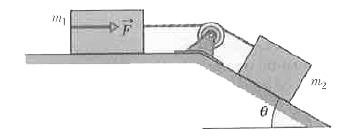 View Solution
View SolutionQuestion 51
Figure 5-50 shows Atwood's machine, in which two containers are connected by a cord (of negligible mass) passing over a frictionless pulley (also of negligible mass). At time t = 0, container 1 has mass 1.30 kg and container 2 has mass 2.80 kg, but container 1 is losing mass (through a leak) at the constant rate of 0.200 kg/s. At what rate is the acceleration magnitude of the containers changing at (a) t = 0 and (b) t = 3.00 s? (c) When does the acceleration reach its maximum value ? View SolutionQuestion 52
Figure 5-60 shows a section of a cable-car system. The maximum permissible mass of each car with occupants is 2750 kg. The cars, riding on a support cable, are pulled by a second cable attached to the support tower on each car. Assume that the cables are taut and inclined at angle θ=35∘. What is the difference in tension between adjacent sections of pull cable if the cars are at the maximum permissible mass and are being accelerated up the incline at 0.81 m/s2 ?
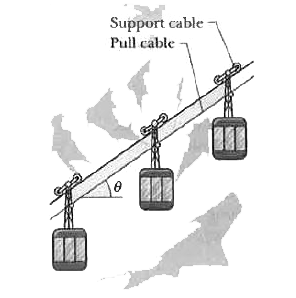 View Solution
View Solution

